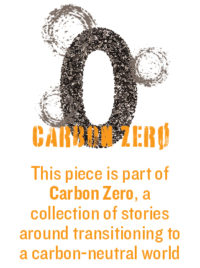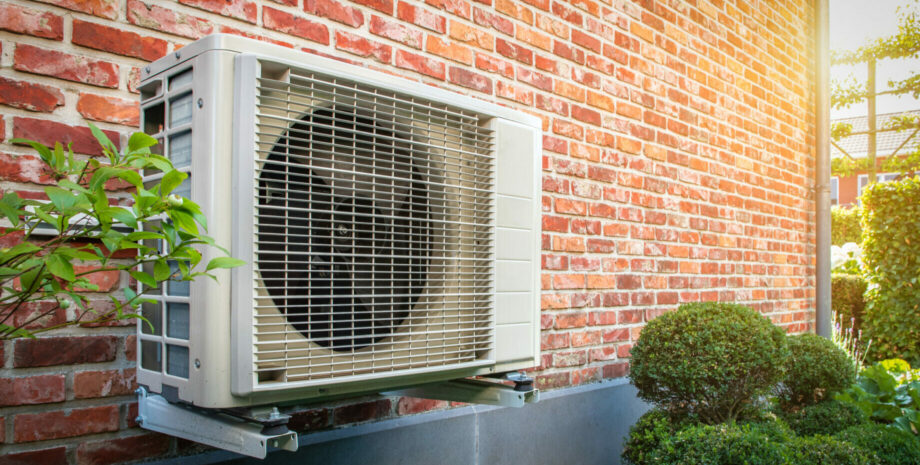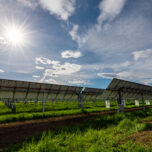March 30, 2023 —  When a powerful Arctic front arrived in Denver late last year, my husband and I crossed our fingers, hoping that our new heat pump could handle the cold blast. On December 22, during what became Denver’s second coldest day on record, we were warm and cozy in our home. Our heat pump worked.
When a powerful Arctic front arrived in Denver late last year, my husband and I crossed our fingers, hoping that our new heat pump could handle the cold blast. On December 22, during what became Denver’s second coldest day on record, we were warm and cozy in our home. Our heat pump worked.
Heat pumps are devices that warm your home in the winter by pumping in heat from underground or from outside air and cool your space in the summer by pulling heat out of indoor air. They don’t generate heat like gas furnaces do — they simply relocate heat from underground or from the air outside your home.
They’re efficient. And if the electricity they use comes from renewable sources, like solar, geothermal or wind energy, they don’t require greenhouse gas–emitting fossil fuels like natural gas, propane or oil furnaces do.
My home state of Colorado has pledged to transition to 100 percent renewable energy by 2040, so we decided to make the switch to a heat pump two years ago. It wasn’t easy.
“There’s a significant group of people, especially in Denver, that is familiar with heat pump technology and knows it can help offset natural gas use and emissions,” says Mac Prather, manager of Denver’s Residential Energy Efficiency Incentives program. “The big challenge for that group is still just navigating that process.”
That indeed was the challenge for us. Our decision to go with a heat pump was followed by a lot of learning — about both heat pumps and the current challenges of obtaining one. With generous heat pump rebates and tax credits from the Inflation Reduction Act (IRA) kicking in, this seems a good time to share what we learned.
Plan Early
There are a few kinds of heat pumps for different climates and house types. Geothermal heat pumps require pipes to be dug into trenches 4 feet (1.2 meters) or more deep, making them ideal for new construction homes. Mini-split heat pumps make it possible to choose different temperatures and schedules for different zones.
Another type is a ducted air source heat pump, which works with a home’s existing heating, ventilation and air conditioning (HVAC) system. This is what we decided to get. But first, we had an energy audit done to ensure we’d be using the heat generated as efficiently as possible. The audit revealed that our attic insulation needed upgrading.
When it came to choosing a heat pump and installer, we quickly discovered that a good contractor is hard to find — as is a good heat pump model.
A July 2020 report for the Colorado Energy Office observed that “many HVAC or plumbing contractors actively discourage or simply do not sell heat pump technologies.”
We made the mistake of interviewing HVAC agents before we knew what brand and model performed the best in our climate. Homeowners lack a consumer-friendly heat pump comparison tool that will take house type, energy use, climate zone and budget into consideration. They also lack independent data-supported reviews of all models and brands. There are no exhaustive reviews or rankings of heat pumps similar to Edmunds Compare Cars Tool, Kelley Blue Book or Autotrader. The fact that heat pumps are climate specific makes things more complicated.
A Reluctant Industry
Not only that, but there is a lot of hesitation in the HVAC industry around the technology.
A July 2020 report for the Colorado Energy Office observed that “many HVAC or plumbing contractors actively discourage or simply do not sell heat pump technologies.” It attributed the reluctance to “outdated perspectives on heat pump performance, a lack of expertise on how to design and install systems or concerns over installing and servicing unfamiliar technology.”
“Previously, concerns about the effectiveness of heat pumps in cold weather, when the air itself has very little heat, have slowed the adoption of this technology in places with cold winter climates such as Colorado,” says Dominique Gomez, deputy director of the Colorado Energy Office. “Recent developments in air source heat pump technology, including heat pumps specifically made for cold-weather climates, have proven heat pumps to be effective even on the coldest winter days.”
Elsewhere in the country, the gas industry is actively discouraging the public from ditching gas furnaces. In the Northeast, representatives of the propane industry are working to discourage homeowners from switching from propane to electric heating alternatives.
We saw some pushback firsthand in Colorado. One contractor told us that climate change was a hoax and that we were better off with a gas furnace. Others struggled to answer our questions. One knew what he was talking about, but his company didn’t sell our preferred brands.
“We’re trying to get the cost of those heat pumps down so that it’s comparative to what it would cost for them just to replace their furnace.” –Nikki Maline
Most of the work in this process fell to us. We took quotes from various contractors, checked those against online specs from manufacturers, and then ranked our choices by efficiency, noise, reliability, price, supply chain availability, and how easy it was to work with the HVAC contractor.
The contractor we ended up going with took care of both the heat pump installation and the electric panel upgrade we found out we needed. In all, our heat pump quest took a year, when we thought it would only take three to four months.
Getting to Parity
Denver is developing consumer guides for heat pumps and is helping build case studies to give homeowners an idea of what it would cost to operate different kinds of heat pumps in Colorado’s different climates.
Meanwhile, the local utility in Colorado’s picturesque ski counties, about 100 miles (161 kilometers) west of Denver, provides an example of how to give consumers information they need and how to make heat pumps affordable.
In 2020, according to Lisa Reed, energy programs manager at Holy Cross Energy, only two customers took advantage of rebates up to US$600 per ton to install cold climate electric heat pumps (generally, a 1,500-square-foot home requires a 3-ton heat pump). The company co-produced community presentations and videos with Walking Mountains Science Center on heat pumps in 2021, and rebate applications for that year jumped to 53 residents. In 2022, they raised their rebate to up to 25% of a qualifying project’s total cost up to $3,000 — convincing 58 residents to apply for rebates. This year, they raised the rebate ceiling again to US$5,000.
“We’re trying to get the cost of those heat pumps down so that it’s comparative to what it would cost for them just to replace their furnace,” says Nikki Maline, the science center’s energy programs director and an energy coach.
Xcel Energy, which provides 53% of electricity in Colorado, including the Denver–Boulder metro area, says on its website that it offers up to US$1,500 in rebates for air source heat pumps.
“With financial incentives and increased consumer demand for heat pumps, we expect contractors will become more familiar with the technology, prices will go down, and many previously skeptical contractors will become heat pump evangelists.” –Dominique Gomez
For households with annual incomes below 80% of an area’s median income, the IRA rebate may cover up to 100% of the total cost, capped at US$8,000. Households with annual incomes at 80% to 150% of an area’s median income can receive rebates that cover up to 50% of the cost, also capped at US$8,000. There will be no rebates for households that earn more than 150% of an area’s median income.
Insulation and electric panel upgrades will often accompany switching to a heat pump, and local utilities often offer rebates for those as well. In addition, the IRA will offer up to US$S4,000 for an electric panel upgrade and up to US$1,600 for insulation.
On top of local utility and IRA rebates, homeowners can receive a federal tax credit for 30% of the costs, capped at US$2,000, of buying and installing a heat pump starting in 2023. States might also offer credits and sales tax exemptions.
The Bottom Line
Our heat pump alone cost us about US$12,000 more than if we had just replaced the furnace — and the process is not for the faint of heart.
In order to reach parity on costs with natural gas, propane or oil furnaces, a consumer using a heat pump would have to take advantage of the IRA and other rebates and live in “climates where the electricity price is not substantially above the national average,” says Christopher Dymond, senior product manager with the Northwest Energy Efficiency Alliance. “The tax credit should [also] be enough to cover the incremental cost of upgrading from an [air conditioning] unit that only provides cooling to a [heat pump] which does heating and cooling.”
December 2022 data from the Energy Information Administration show that electricity prices in 33 states were below the national average of 14.96 cents per kilowatt-hour (kWh) for the month. The rest were slightly higher than the national average, but lower than Massachusetts’ rate of 30.73 cents per kWh, New Hampshire’s 30.92 cents per kWh, and Hawaii’s at 44.78 cents per kWh.
And then there’s the question of contractor education and reliability. Dymond, who is also a founding member of the Advanced Heat Pump Coalition — a group of what Dymond calls “energy-efficiency nerds” who share knowledge about technical heat pump research — admits that “getting the right heat pump is not easy. … It will take a while in parts of the country unfamiliar with modern heat pumps.” Dymond recommends getting multiple bids, “as contractor skills vary substantially.”
With contractor reliability still a question mark, consumers can look to coaches — like Prather in Denver and Maline in Avon, Colorado — to help figure out the right heat pump for their homes before meeting with installers and contractors. Some work for city energy offices, some work as private consultants, and some are volunteers.
In the end, we’re glad we went with a heat pump because of the efficiency and annual savings we hope to enjoy. Our electric bills were higher late last year because of higher natural gas prices, so as our state moves to more renewables for energy production, our decision will make even more sense. But in order to see widespread adoption of this technology, the process we went through will likely have to get quite a bit easier. Gomez with the Colorado Energy Office is optimistic.
“With financial incentives and increased consumer demand for heat pumps, we expect contractors will become more familiar with the technology, prices will go down, and many previously skeptical contractors will become heat pump evangelists,” she says.
Editor’s note: Natasha Vizcarra wrote this story as a participant in the Ensia Mentor Program. The mentor for the project was Peter Fairley.
Related Posts
Ensia shares solutions-focused stories free of charge through our online magazine and partner media. That means audiences around the world have ready access to stories that can — and do — help them shape a better future. If you value our work, please show your support today.
Yes, I'll support Ensia!




